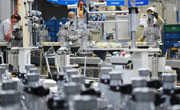Brussels-Capital Region(Belgium)
Brussels-Capital Region(Belgium)
[Overview] The Brussels-Capital Region is located on the banks of the Senne, a tributary of the Schelde River in central Belgium. The region covers an area of 161 square kilometers and has a population of 1.19 million.
[Politics] The Brussels-Capital Region comprises 19 municipalities, including the City of Brussels, which is the capital of Belgium. The region has supervisory and partial financial authority over the municipalities under its jurisdiction, and the laws of the region apply to all the municipalities. The governing bodies of the region include the Parliament and the Government. The Parliament is the legislative body of the region. Its main duties are to legislate, review and approve the budget, and supervise the Government. It is made up of 89 members, elected by citizens in 19 municipalities for a term of five years. The Government is the region's executive body and is elected by the Parliament. It comprises one minister-president (equivalent to the mayor), four ministers (equivalent to deputy mayors) and three secretaries of state, elected for a term of five years. The incumbent Minister-President, Rudi Vervoort, took office in May 2013.
[Economy] The Brussels-Capital Region is Belgium's second largest economic center, second only to Antwerp, and ranks among the top European business cities, characterized by frequent business activities. There are many industrial and technological parks in the region. The tertiary sector is the mainstay of the region's economy. Banking, insurance, finance, transportation, chemicals, and tourism are the region's pillar industries. In recent years, its biotechnology and telecommunications industries have developed rapidly. There are thousands of foreign trade companies in the region, mostly small and medium-sized ones, and more than half of the region's products are exported.
[Culture and Education] Education in the Brussels-Capital Region can be divided into community education (including kindergarten, primary and secondary education), vocational education and higher education. The Université libre de Bruxelles and the Vrije Universiteit Brussel are in the region. There are also many European and international schools and special schools. The region integrates Latin and Germanic cultures. It is a part of both the French Community of Belgium and the Flemish Community and thus a bilingual region (French and Flemish), with rich cultural heritage. The Grand Place of Brussels and Major Town Houses of the Architect Victor Horta are listed as UNESCO World Heritage Sites.
[Relations with Beijing] On September 22, 1994, Beijing and the Brussels-Capital Region established a sister city relationship. On October 21, 2014, the Cooperation Agreement between Beijing and the Brussels-Capital Region was signed. In recent years, the two sides have maintained good official ties and engaged in exchanges and cooperation in the fields of investment, trade, culture, education, tourism, science and technology, and urban planning and management.
Investment and Trade: The Beijing International Trade in Services Center (the executive agency of the China International Fair for Trade in Services) and the Beijing Investment Promotion Service Center have maintained exchanges and collaborations with the Foreign Investment and Trade Promotion Authority of Brussels. The Beijing Investment Promotion Service Center has signed a memorandum of cooperation with hub.brussels, the Brussels Agency for Business Support.
Culture and Tourism: The Brussels-Capital Region joined the World Tourism Cities Federation (WTCF) established on the initiative of Beijing in 2012 and has since then sent representatives to attend the WTCF Fragrant Hills Tourism Summit every year. Since 2012, the Brussels-Capital Region has held the Brussels Food Festival in September each year. Beijing has sent outstanding catering companies to the region for eight consecutive years to participate in the food festival. In October 2014, to celebrate the 20th anniversary of the sisterhood between the two sides, the Brussels-Capital Region held the Brussels Day event in Beijing, including the “Breaking Out of the Door: Legacy and Imitation” modern art exhibition and a tourism seminar. In September and November 2019, to celebrate the 25th anniversary of the sisterhood, the Brussels-Capital Region presented Benoit+Bo's solo exhibition “Garden” and a banquet in Beijing.
布鲁塞尔首都大区(比利时)
【概况】布鲁塞尔首都大区位于比利时中部斯海尔德河支流桑纳河畔,面积161平方公里,人口119万。
【政治】布鲁塞尔首都大区下辖包括首都布鲁塞尔市在内的19个市镇。大区对所辖市镇具有监管和部分财政管理权限,大区法律适用于所辖市镇。大区领导机构包括大区议会和大区政府。大区议会是大区立法机构,主要职责为立法、审议通过预算、监督大区政府。议会共有89名议员,由19个市镇的选民经普选产生,任期5年。大区政府是大区执行机构,由议会选出,包括1名首席大臣(相当于市长)、4名大臣(相当于副市长)和3名国务秘书,任期5年。现任首席大臣卢迪·韦尔沃特于2013年5月就职,2019年7月连任。
【经济】布鲁塞尔首都大区仅次于安特卫普,是比利时第二大经济中心,在欧洲商业城市排名中位居前列,经济商务活动频繁。大区内有众多工业园区和科技园区,经济活动以第三产业为主,支柱产业有银行、保险、金融、交通、化工、旅游等。近年来,生物技术和电信业发展迅速。在对外贸易领域,大区内有数千家外贸企业,以中小企业居多,超过一半的大区产品用于出口。
【文化教育】布鲁塞尔首都大区教育包括社区教育(含幼儿园、初级和中级教育)、专业教育和高等教育。拥有法语布鲁塞尔自由大学和弗拉芒语布鲁塞尔自由大学,还有众多欧洲与国际学校以及特殊学校。大区位于拉丁文化和日耳曼文化交汇点,是法语和弗拉芒语双语区,文化事业发达。布鲁塞尔市政厅大广场、维克多·奥尔塔纪念馆等被列入世界文化遗产名录。
【两市交往】1994年9月22日,北京市与布鲁塞尔首都大区正式建立友好城市关系。2014年10月21日,两市区签署《北京市与布鲁塞尔首都大区合作协议》。近年来,两市区保持着良好的官方往来,双方在经贸、文教、旅游、科技、城市规划管理等领域开展了诸多交流与合作。
经济贸易:我市国际服务贸易事务中心(京交会执行机构)、市投资促进服务中心与布鲁塞尔外国投资与贸易促进局保持着良好的交流合作。市投资促进服务中心与布鲁塞尔外国投资与贸易促进局签有合作备忘录。
文化旅游:2012年,布鲁塞尔首都大区首批加入由我市发起成立的世界旅游城市联合会,并每年派代表出席世界旅游城市联合会香山旅游峰会。自2012年起,布鲁塞尔首都大区于每年9月举办“布鲁塞尔美食节”活动,我市已连续八年选派优秀餐饮企业赴大区参加美食节活动。2014年10月,为庆祝两市区结好20周年,布鲁塞尔首都大区在京举办“布鲁塞尔日”活动,包括“破门而出:师传与模仿”现代艺术展、旅游研讨会等。2019年9月和11月,为庆祝两市区结好25周年,布鲁塞尔首都大区在京举办“东波西波园林艺术展”和北京—布鲁塞尔结好25周年庆祝宴会等活动。
(Source: Foreign Affairs Office of Beijing Municipal Government)
[ Editor: WPY ]










More From Guangming Online
Medics from Fujian leave for Shanghai to aid in battle against COVID-19 resurgence
New int'l land-sea transport service to Indo-China Peninsula launched
Another makeshift hospital under construction in Shanghai
Tourists view tulips in Suiping County, Henan
In pics: blooming gagea flowers on grassland in Zhaosu, Xinjiang
Greek workers stage 24-hour general strike over high prices